Creating a small garden layout can be a fun and rewarding experience, allowing you to maximize every inch of your outdoor space. With a bit of creativity and planning, you can transform a compact area into a beautiful oasis that reflects your style and meets your gardening goals. Let’s dive into some practical tips and ideas to help you design the perfect small garden.
Creating Layered Planting for Depth
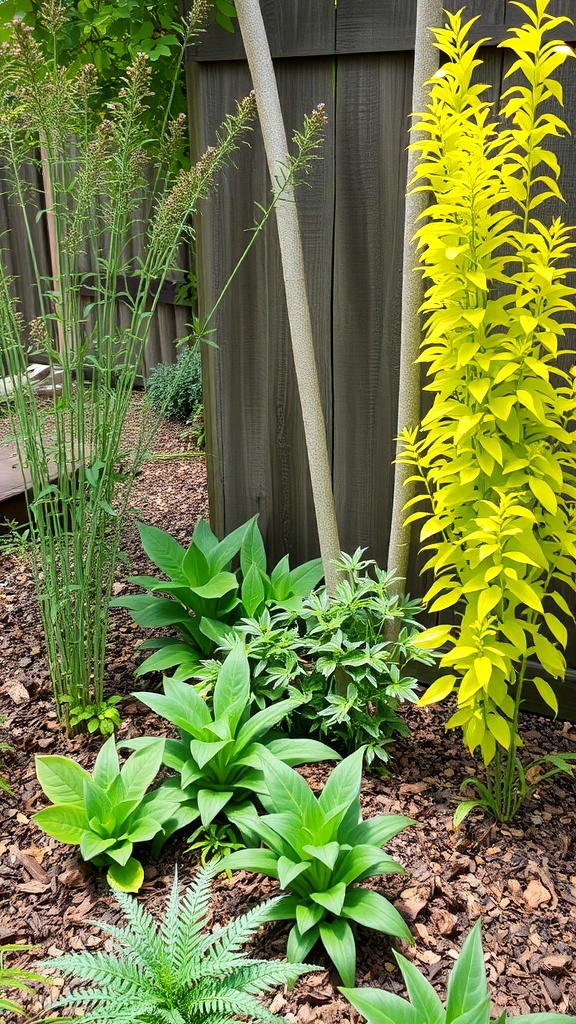
Layered planting is a fantastic way to add depth and interest to your small garden. The image shows a vibrant arrangement of plants, showcasing how different heights and colors can work together beautifully.
In the foreground, you can see lush green leaves that create a soft base. These plants are perfect for filling in space and providing a rich backdrop. Just behind them, there are taller plants that add vertical interest. This layering effect draws the eye upward, making the garden feel more expansive.
The bright yellow plant on the right stands out and adds a pop of color. It contrasts nicely with the greens, making the garden lively and inviting. Incorporating various textures, like the feathery fern at the bottom, enhances the visual appeal.
When planning your garden, think about how you can arrange plants in layers. This technique not only looks great but also allows for better light and air circulation among the plants. It’s a simple way to create a more dynamic and engaging space.
Maximizing Vertical Space in Small Gardens
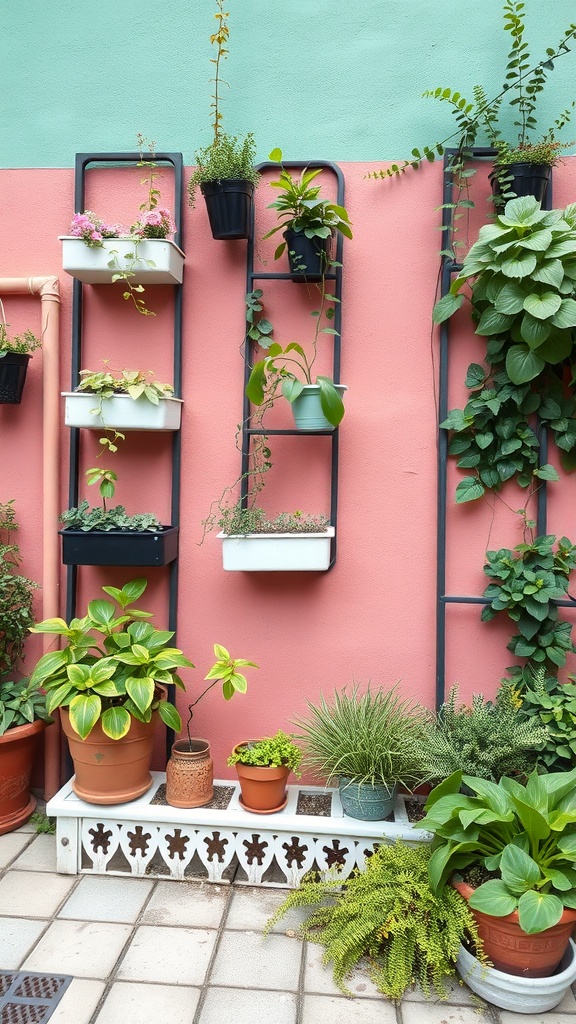
Small gardens can be a challenge, but they also offer a chance to get creative. One great way to make the most of limited space is by using vertical gardening techniques. The image shows a colorful wall adorned with various plants in pots, showcasing how you can utilize vertical space effectively.
The arrangement features several shelves mounted on the wall, each holding different plants. This not only saves ground space but also adds visual interest. The vibrant pink wall contrasts beautifully with the greenery, making the garden feel lively and inviting.
Incorporating vertical elements like these shelves allows you to grow more plants without taking up valuable floor space. You can mix and match different types of plants, from trailing vines to small flowering plants, to create a dynamic look. This approach can turn a plain wall into a stunning focal point.
Consider using lightweight pots and sturdy brackets to ensure everything is secure. You can even add hooks for hanging plants, which adds another layer of dimension. With a little planning, your small garden can become a vertical paradise!
Creating a Cozy Seating Area
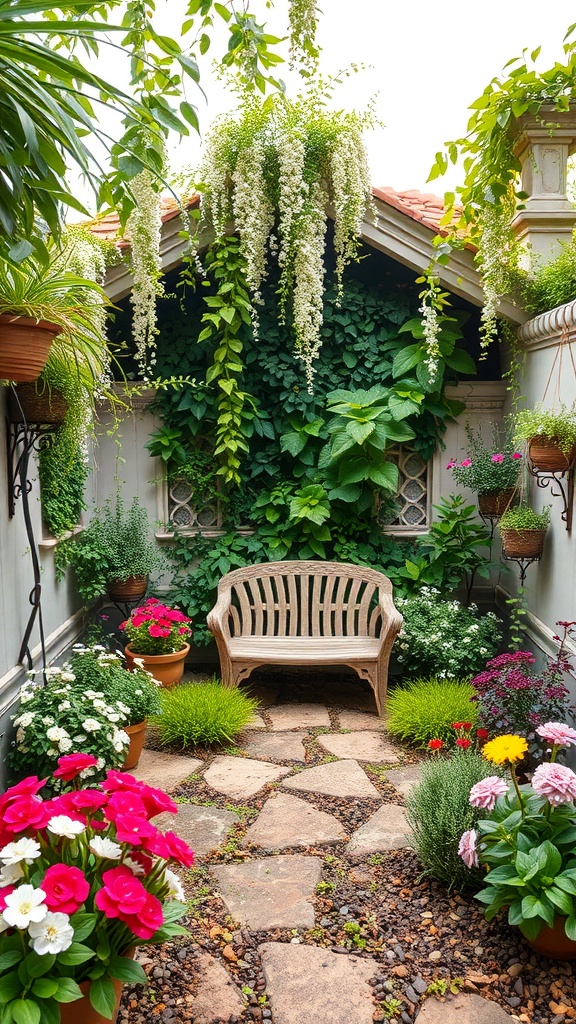
A small garden can be a perfect spot for relaxation. The image shows a charming seating area surrounded by vibrant flowers and lush greenery. A wooden bench sits invitingly on a stone path, making it an ideal place to unwind.
The colorful blooms add life to the space, while the greenery creates a refreshing atmosphere. Hanging plants drape gracefully, enhancing the cozy feel. This setup encourages you to sit back, sip a drink, and enjoy nature’s beauty.
To create a similar cozy seating area, think about your favorite plants and colors. Choose comfortable seating that fits your style. Adding cushions can make the bench even more inviting. Consider using potted plants to frame the seating, creating a natural barrier that adds privacy.
Incorporating Water Features
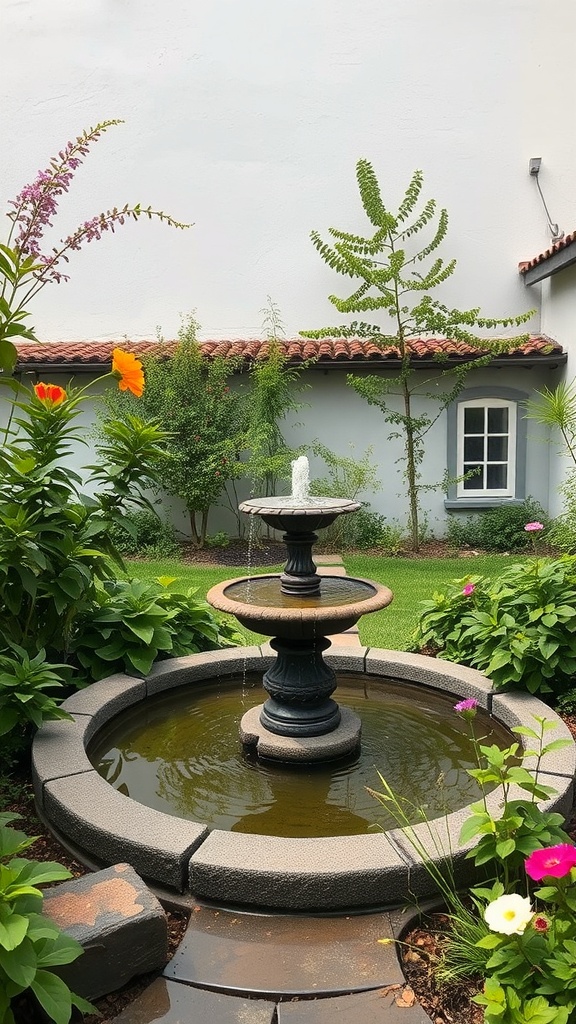
Water features can bring a small garden to life. The image shows a charming fountain surrounded by vibrant flowers and greenery. This setup not only adds beauty but also creates a soothing atmosphere.
A fountain like this can be the focal point of your garden. The gentle sound of water can make your space feel more peaceful. It invites relaxation and can even attract birds and butterflies, adding to the garden’s charm.
When planning your layout, think about where to place your water feature. Position it where you can easily enjoy it from seating areas. Surround it with colorful plants to enhance its appeal. Consider different heights and textures to create visual interest.
Small gardens can benefit from water features without overwhelming the space. A compact fountain can fit nicely, providing the calming effect of water without taking up too much room. Plus, it can be a great conversation starter for gatherings.
Using Containers for Flexibility
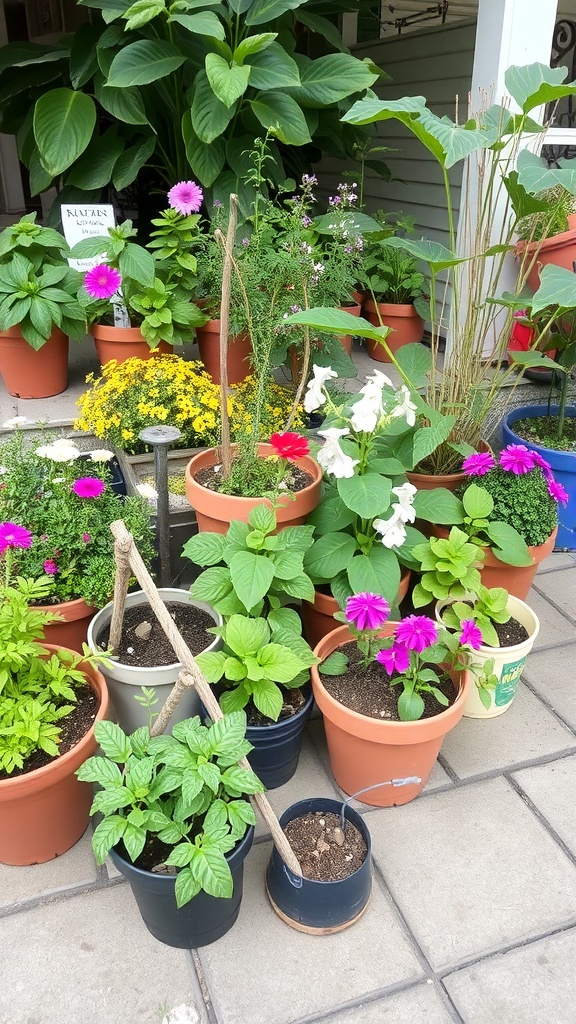
Containers are a fantastic way to bring life to a small garden. The image shows a vibrant collection of potted plants, each adding its own charm. With different shapes and sizes, these pots create a lively scene.
Using containers allows you to rearrange your garden easily. If you want to change the look or make space for new plants, just move the pots around. This flexibility is perfect for small spaces where every inch counts.
Another benefit is that containers can accommodate various plants. You can mix flowers, herbs, and even small vegetables. This variety not only looks great but also provides options for cooking or decorating your home.
Don’t forget about the materials! You can choose from clay, plastic, or even recycled items. Each material has its own style and can contribute to the overall theme of your garden.
Lastly, containers can help manage soil quality. You can fill them with the best soil mix for your plants, ensuring they get the nutrients they need. This is especially helpful in urban areas where ground soil might not be ideal.
Designing Pathways for Accessibility
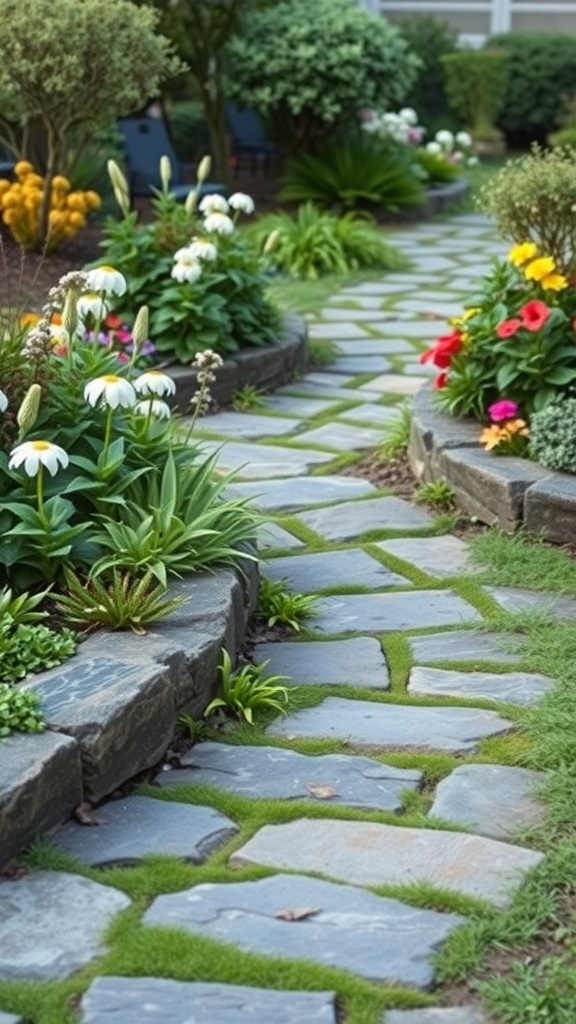
Creating pathways in your small garden is key to making it accessible for everyone. The image shows a charming stone pathway lined with vibrant flowers and greenery. This design not only looks inviting but also helps guide visitors through the garden.
When planning your pathways, think about the materials you want to use. The stones in the image provide a sturdy surface that is easy to walk on. They also blend beautifully with the surrounding plants, making the garden feel cohesive.
Consider the width of your pathways. They should be wide enough for people to walk comfortably, especially if you expect foot traffic. A path that is too narrow can feel cramped and unwelcoming.
Adding plants along the edges, like in the image, creates a natural border. This not only enhances the visual appeal but also helps define the pathway. Choose low-maintenance plants that thrive in your climate for a beautiful, hassle-free garden.
Finally, think about accessibility for everyone. If you have visitors with mobility challenges, ensure your pathways are smooth and even. This makes it easier for wheelchairs or walkers to navigate the space. A well-designed pathway can make your garden a joyful place for all.
Incorporating Raised Garden Beds
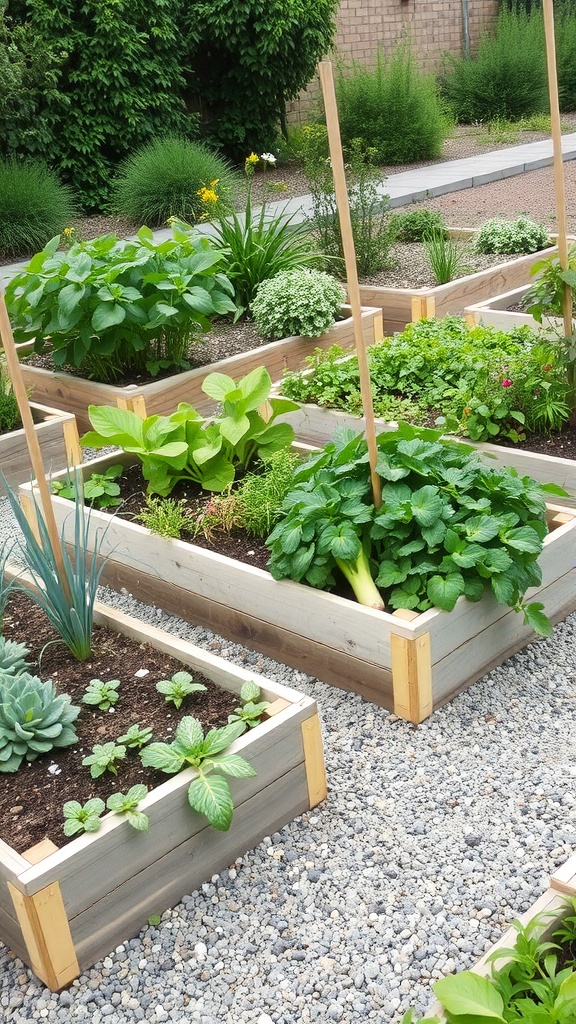
Raised garden beds are a fantastic way to maximize space in a small garden. They not only look neat but also make gardening easier. The image shows several raised beds filled with a variety of plants, from leafy greens to herbs.
One of the biggest benefits of raised beds is improved drainage. This is especially helpful in areas where the soil tends to retain water. The wooden frames keep the soil contained and allow for better root growth. You can see how the plants are thriving in the image, showcasing a healthy mix of vegetables and herbs.
Another advantage is that raised beds can be customized to fit your needs. You can choose the height, size, and even the materials used. This flexibility allows you to create a layout that works best for your garden space. The beds in the image are well-organized, making it easy to access each plant.
Using raised beds also means less bending over, which is a plus for anyone with back issues. The image highlights how the beds are elevated, making gardening more accessible. This design encourages more people to get involved in gardening, regardless of their physical ability.
Finally, raised beds can add a decorative element to your garden. The clean lines and structured look can enhance the overall aesthetic. In the image, the combination of plants and the gravel path creates a lovely visual appeal, making the garden a pleasant place to spend time.
Choosing the Right Plants for Limited Space
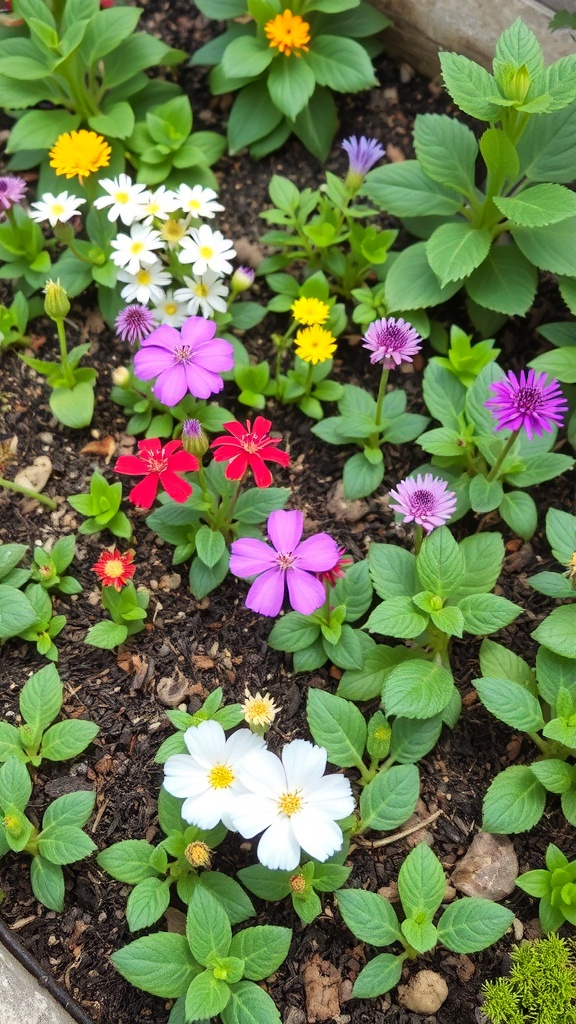
When working with a small garden, selecting the right plants is key to creating a vibrant space. The image shows a colorful mix of flowers, showcasing how a variety of plants can thrive even in tight areas.
Start by choosing flowers that are compact and low-maintenance. The bright blooms in the picture, like the pink and white flowers, are great examples. They add color without taking up too much room. Look for plants that grow well together and complement each other.
Consider the sunlight in your garden. Some plants need full sun, while others prefer shade. The mix of flowers here suggests a balance, which can help keep your garden lively throughout the seasons. Grouping plants with similar light needs can make care easier.
Don’t forget about the soil! Healthy soil is essential for any plant. Adding organic matter can help your flowers flourish. The rich, dark soil in the image looks inviting and ready for growth.
Lastly, think about height and layering. Taller plants can go in the back, while shorter ones can fill in the front. This creates depth and makes your garden visually appealing. The arrangement in the image shows how layering can work beautifully.
Incorporating Decorative Fencing
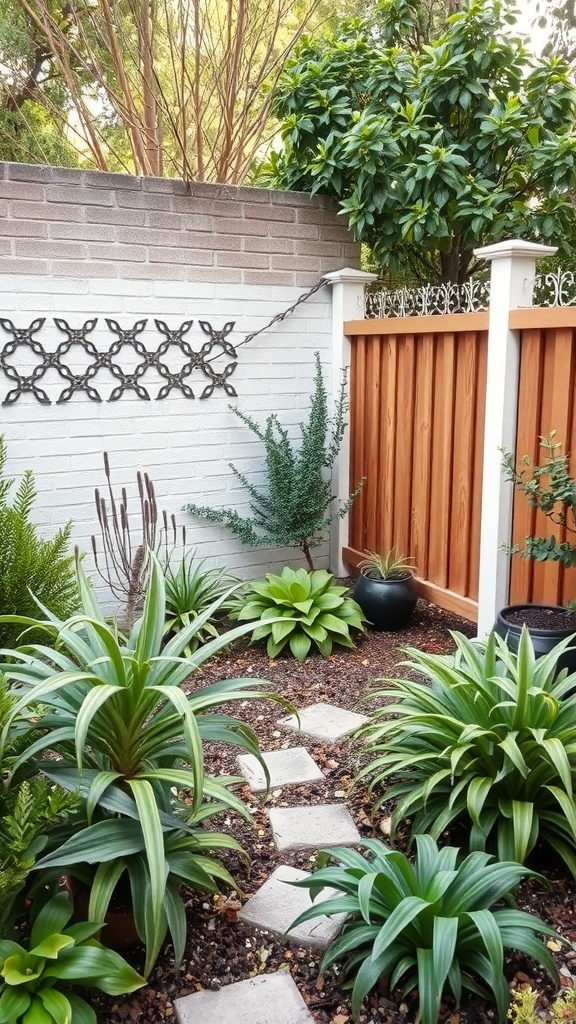
When designing a small garden, decorative fencing can make a big impact. The image shows a charming garden layout with a mix of plants and a stylish fence. The wooden fence adds warmth and structure, creating a cozy feel.
The combination of the tall greenery and the shorter plants creates layers, drawing the eye around the space. The fencing not only defines the area but also provides a backdrop that enhances the overall look. You can choose from various styles, like picket or lattice, to fit your personal taste.
Incorporating decorative elements, like the wall art seen in the image, adds character. This makes the garden feel unique and inviting. A well-placed fence can also offer privacy, making your garden a perfect retreat.
Utilizing Edible Landscaping
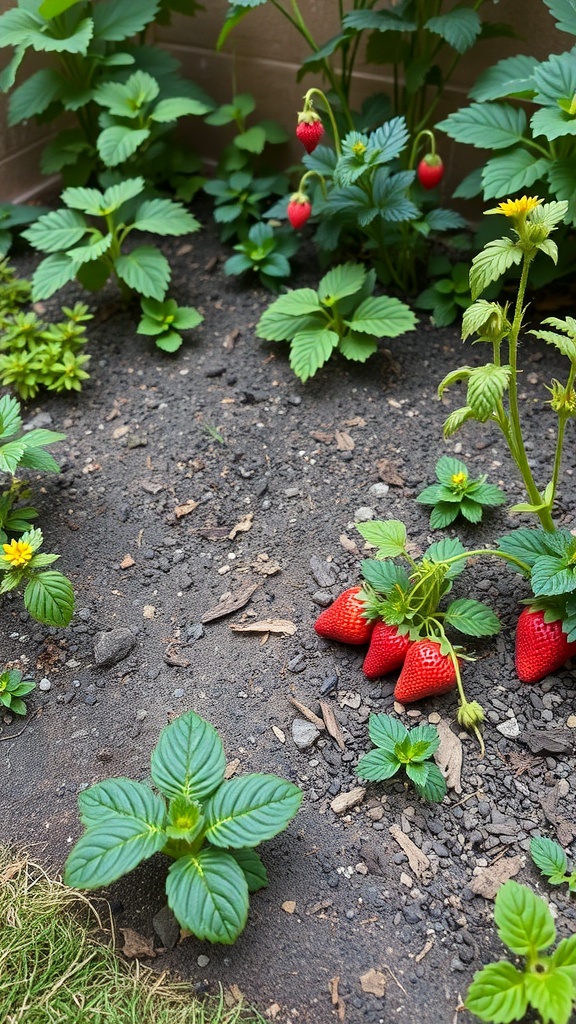
Edible landscaping is a fantastic way to make your garden both beautiful and functional. The image shows a small garden filled with vibrant strawberry plants, showcasing how you can grow delicious fruits right in your backyard.
Incorporating edible plants like strawberries not only adds color but also provides fresh produce. These plants are easy to care for and can thrive in small spaces, making them perfect for compact gardens.
Mixing in other herbs or vegetables can create a diverse and attractive layout. Imagine stepping outside and picking fresh strawberries for breakfast! This approach to gardening allows you to enjoy the fruits of your labor while enhancing your outdoor space.
When planning your garden, think about the layout. Grouping plants with similar needs can make maintenance simpler. Plus, the sight of ripe strawberries peeking through the greenery is sure to bring a smile.
Mixing Hardscape Elements with Softscape
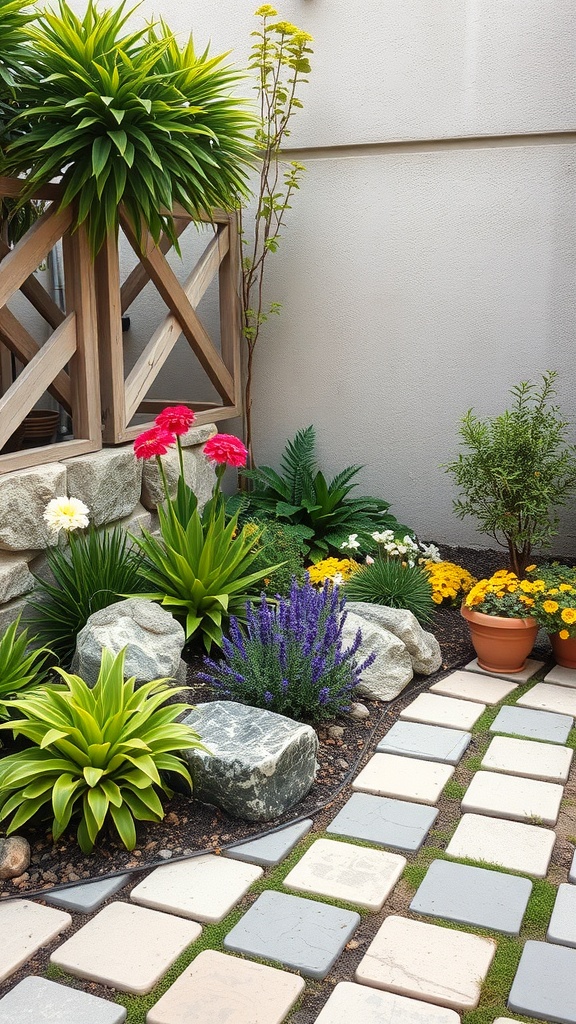
Creating a small garden can be a fun and rewarding experience. In this image, we see a beautiful blend of hardscape and softscape elements that work together harmoniously. The stone pathway leads the eye through the garden, inviting you to explore the vibrant plants and flowers.
The use of different materials, like the smooth stones and wooden fence, adds texture and contrast. This combination not only defines the space but also enhances its visual appeal. The softscape, featuring colorful blooms and lush greenery, brings life and warmth to the area.
Notice how the plants are arranged around the rocks and pathway. This thoughtful layout creates a natural flow, making the garden feel more inviting. Incorporating various heights and colors of plants adds depth and interest, making even a small space feel expansive.
Mixing hardscape and softscape elements is key to achieving a balanced garden design. It allows you to create functional spaces while still enjoying the beauty of nature. Whether you have a tiny balcony or a small yard, this approach can transform your outdoor area into a lovely retreat.
Creating a Wildlife-Friendly Garden
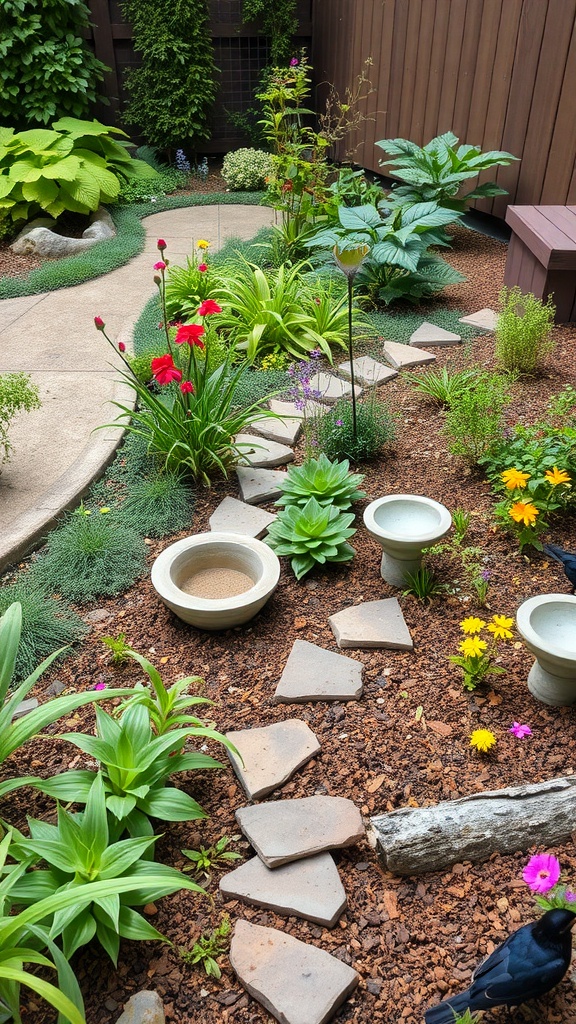
Designing a small garden can be a fun and rewarding experience. This image shows a lovely layout that invites wildlife while keeping things neat and tidy. The winding path made of stones leads through vibrant flowers and lush greenery, creating a welcoming space for various creatures.
Notice the birdbaths placed strategically among the plants. These are perfect for attracting birds, providing them with a place to drink and bathe. Adding such features not only helps birds but also enhances the overall beauty of your garden.
The mix of colorful flowers and leafy plants offers shelter and food for pollinators like bees and butterflies. Choosing native plants can further support local wildlife, making your garden a thriving ecosystem.
With thoughtful design, your small garden can become a haven for wildlife. It’s all about creating spaces that cater to their needs while enjoying the beauty of nature right at home.
Implementing Garden Lighting for Ambiance
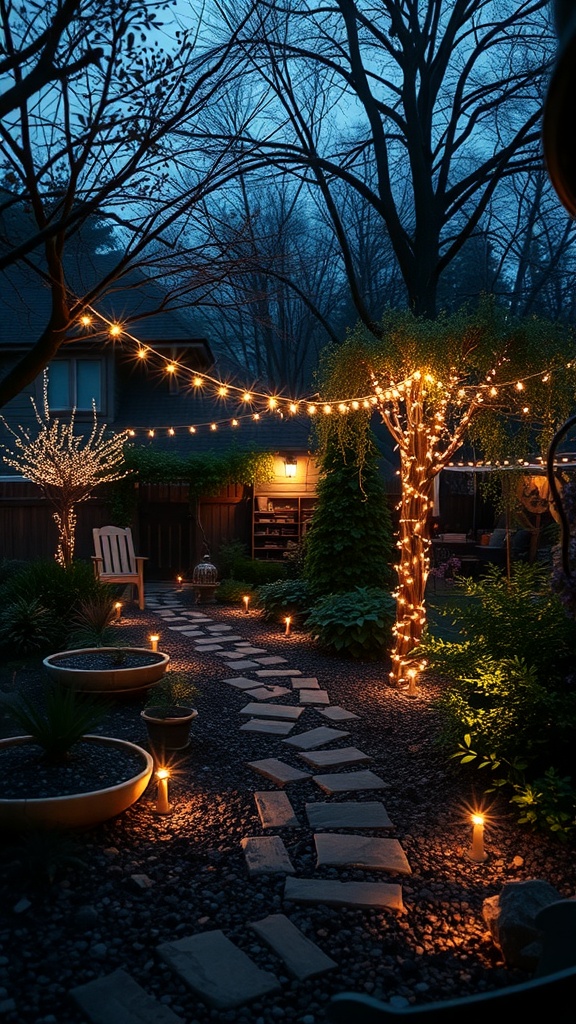
Creating a cozy atmosphere in your small garden can be easily achieved with the right lighting. The image showcases a charming garden path illuminated by soft lights, guiding the way through a peaceful setting. String lights drape gracefully from tree to tree, adding a touch of magic to the space.
Notice how the warm glow from the lights enhances the natural beauty of the plants and stones. Pathway lights line the way, making it safe to stroll through the garden at night. This kind of lighting not only serves a practical purpose but also transforms the garden into a welcoming retreat.
Incorporating different types of lights can create layers of interest. For instance, the twinkling lights in the trees contrast beautifully with the steady glow of the candles along the path. This mix adds depth and warmth, making the garden feel alive even after sunset.
Consider using solar-powered lights for an eco-friendly option. They charge during the day and automatically turn on at night, making them a hassle-free choice. With thoughtful placement, you can highlight your favorite plants or features, turning your small garden into a delightful evening escape.
Adding a Garden Shed for Storage
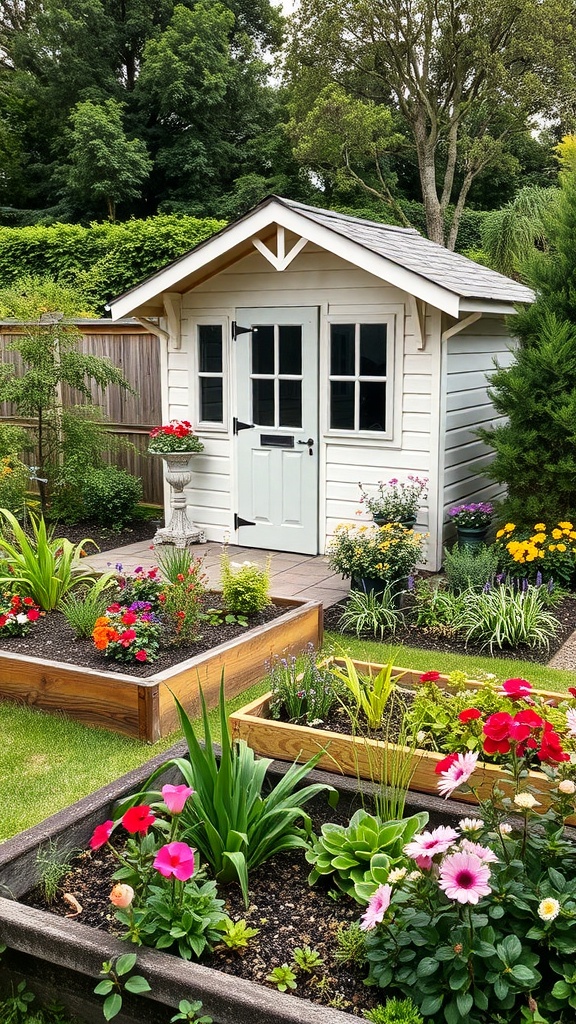
A garden shed can be a fantastic addition to your small garden layout. It provides a dedicated space for storing tools, pots, and other gardening supplies. This not only keeps your garden tidy but also makes it easier to find what you need when you need it.
The image shows a charming garden shed surrounded by vibrant flowers and neatly arranged garden beds. The shed’s design is inviting, with a light color that complements the greenery around it. This kind of shed can serve as a focal point in your garden while being practical.
When planning your shed, think about its size and location. You want it to be accessible but not overpowering in your garden space. Placing it near your planting areas can save time and effort when you’re tending to your plants.
Consider adding shelves or hooks inside the shed to maximize storage. This way, you can keep everything organized and easy to reach. You might also want to personalize it with some decorations or plants around the entrance to make it feel like a part of your garden.
Designing a Themed Garden Corner
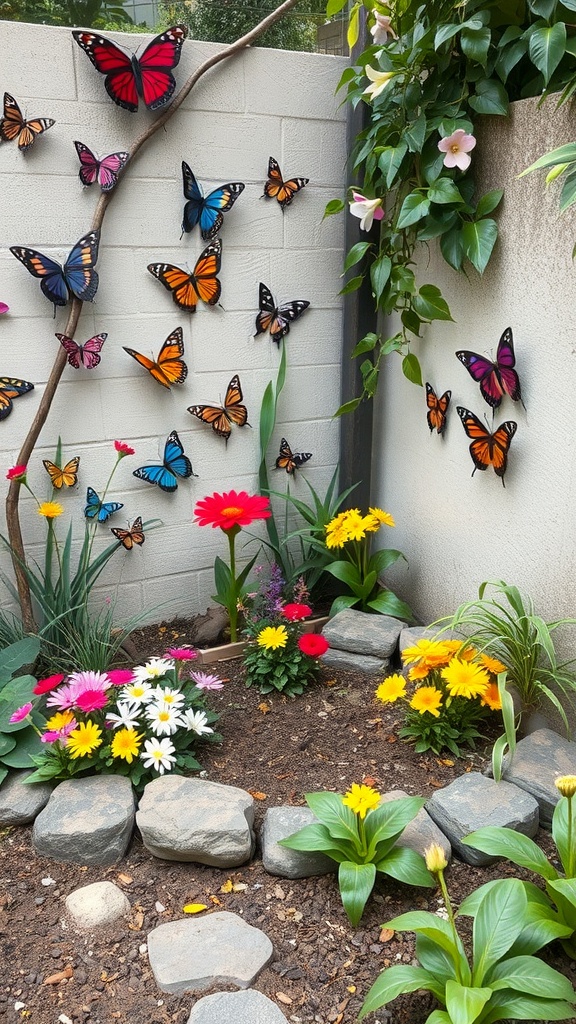
Creating a themed garden corner can transform a small space into a delightful retreat. In the image, we see a vibrant display of flowers surrounded by decorative butterflies. This setup invites a sense of joy and whimsy.
The colorful blooms, including daisies and gerbera daisies, add a cheerful touch. The arrangement of flowers in clusters creates a lively atmosphere, perfect for relaxation or entertaining guests. The use of stones to outline the garden bed adds structure and charm.
The butterflies on the wall enhance the theme, making it feel like a magical escape. They bring a playful element that complements the natural beauty of the flowers. Consider incorporating similar decorations to personalize your own garden corner.
When designing your themed garden, think about colors and elements that resonate with you. Whether it’s butterflies, birds, or another motif, let your creativity shine. A small garden can be a big source of happiness!
Designing for Seasonal Interest
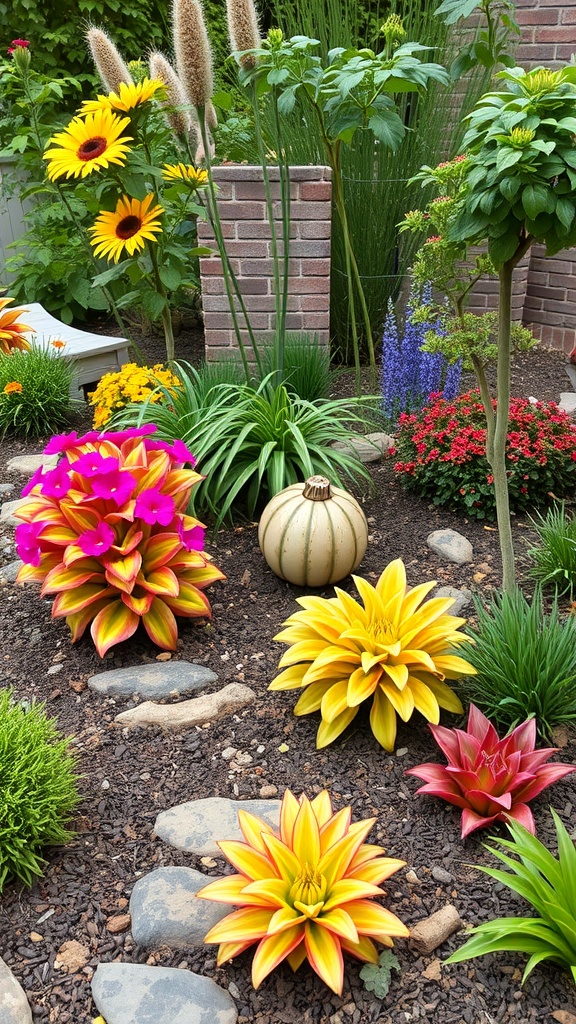
Creating a small garden that shines throughout the seasons is a fun challenge. The image showcases a vibrant layout filled with colorful flowers and unique decorations. Sunflowers stand tall, adding a cheerful touch, while the bright blooms in pink, yellow, and red create a lively atmosphere.
Incorporating various plants ensures that there’s always something to admire. The mix of textures and colors invites curiosity and joy. The stones along the path guide visitors through this delightful space, making it easy to appreciate each element.
Seasonal interest can be achieved by selecting plants that bloom at different times of the year. For instance, sunflowers bring summer cheer, while other plants can provide fall colors. This thoughtful planning keeps the garden looking fresh and engaging.
Vertical Gardening Solutions
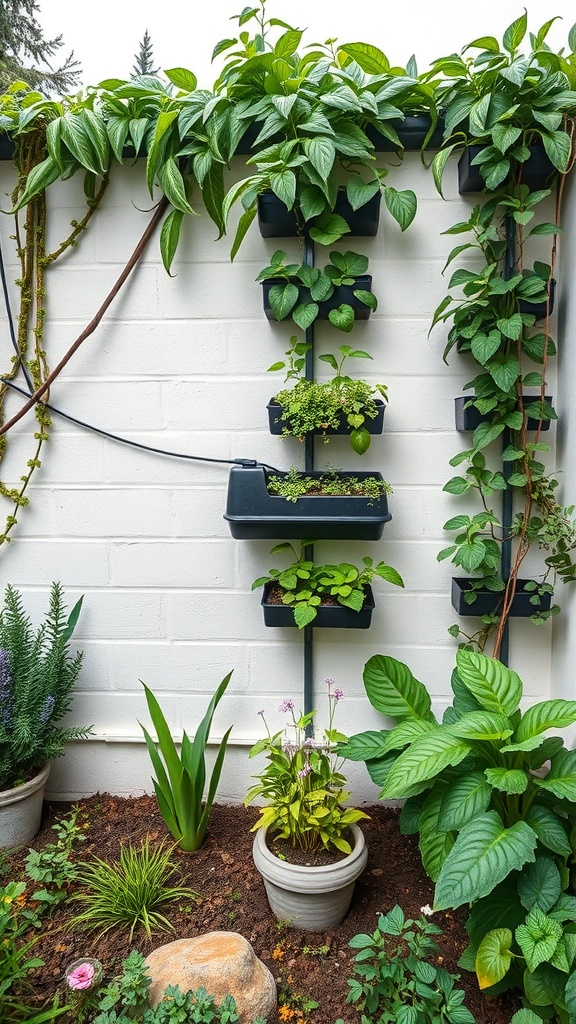
Vertical gardening is a fantastic way to maximize space, especially in small gardens. The image showcases a creative setup where plants are arranged vertically against a wall. This method not only saves ground space but also adds a unique visual appeal to your garden.
The wall-mounted planters are filled with a variety of plants, including leafy greens and colorful flowers. This diversity can enhance your garden’s aesthetics while providing fresh produce right at your fingertips. The use of a sturdy support system ensures that the plants can thrive without taking up valuable ground space.
Incorporating vertical gardening solutions allows you to grow more in less area. You can easily create a lush green wall that acts as a natural privacy screen or simply a beautiful backdrop. This approach is perfect for urban settings where space is limited.
Consider adding herbs or trailing plants to your vertical garden for added texture and functionality. With a little creativity, you can transform any small area into a vibrant green space.
